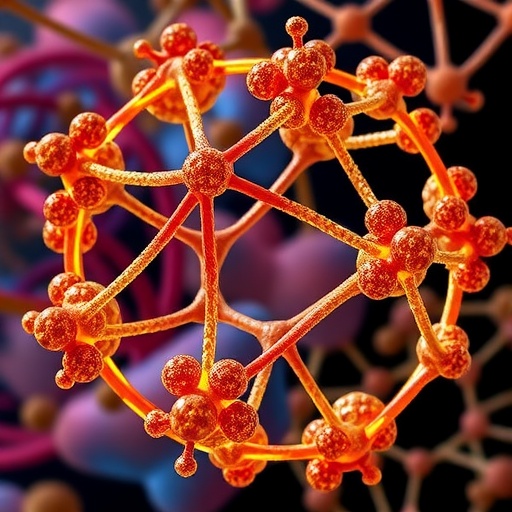In a groundbreaking revelation that bridges multiple disciplines from materials science to biomedical engineering, researchers have uncovered a universal principle governing how diverse particles self-organize under confinement. This discovery challenges long-standing perceptions about particle behavior by demonstrating that vastly different entities—ranging from simple soap bubbles to solid ball bearings—can spontaneously arrange themselves into identical geometric patterns when subjected to specific confining forces. The insight opens new avenues not only for designing novel materials with highly specialized properties but also for advancing medical technologies such as targeted drug delivery and tissue engineering.
At the heart of this study lies a deceptively simple yet powerful mathematical model which captures the delicate balance between two fundamental forces: the repulsive interactions among particles and the spatial constraints imposed by their environment. By finely tuning these opposing influences, the researchers were able to predict with remarkable accuracy the equilibrium configurations that these particles adopt. This universality of patterns, emerging regardless of the particles’ material nature or scale, underscores a profound natural order that transcends individual physical properties.
The international collaboration, led by Dr. Paulo Douglas Lima of Brazil’s Federal University of Rio Grande do Norte and including Professor Simon Cox from Aberystwyth University’s Department of Mathematics, conducted a series of meticulous experiments utilizing diverse particle systems. Floating magnets, steel ball bearings, and delicate soap bubbles were each confined within specially designed containers to emulate different confinement conditions. Despite their intrinsic differences—in elasticity, mass, and interaction forces—all these particles conformed to the same geometric arrangements, validating the theoretical framework.
Such findings bear significant implications on a practical level, especially in the biomedical field. For instance, the ability to engineer particles that self-assemble predictably under confinement could revolutionize the development of drug delivery systems. Smart capsules that release therapeutics at controlled rates or in response to specific triggers rely heavily on the organization of particulate matter at microscopic scales. The universal principles detailed by this research offer a blueprint for tailoring these assemblies to achieve maximum efficacy and precision in treatment.
Beyond medical applications, the principles governing particle self-assembly provide fresh perspectives on the natural organization of biological tissues. Understanding how cells pack tightly while maintaining functionality is crucial to designing synthetic scaffolds that mimic natural tissue architecture. This research provides a mechanistic foundation that can guide bioengineers in crafting regenerative materials that promote optimal cellular organization and growth, potentially accelerating advances in regenerative medicine and organ repair.
The study’s underpinning mathematical model captures the competition between particle-particle repulsion and the degree of spatial confinement with elegant simplicity. This model posits that as particles repel each other, they attempt to maximize their mutual distances; simultaneously, the confining environment restricts their freedom to spread. The resultant compromise leads to highly ordered configurations, often forming clusters or shells of particles arranged in precise symmetrical patterns. Importantly, the model extends across scales and materials, marking a significant step toward a unified understanding of confined particle behavior.
Experimentally, the researchers’ approach was as innovative as their theoretical insight. Utilizing floating magnets involved creating repulsive dipole forces that kept each magnet apart within a two-dimensional plane, effectively simulating ideal conditions for observing self-assembly under repulsive confinement. In contrast, ball bearings provided a tangible example of granular materials, while soap bubbles illustrated soft, deformable particles governed by surface tension and minimal friction. These varied experiments reinforced the robustness of the theoretical predictions, demonstrating that the self-organizing phenomenon is not limited by particle rigidity or interaction type.
Professor Simon Cox remarked on the elegance of these findings, emphasizing how disparate systems converge to similar arrangements under confinement. He highlighted that the universality of these patterns serves as a compelling example of nature’s propensity towards order, even amidst apparent complexity and variability. This realization presents vast opportunities to harness these principles in engineered systems, potentially transforming manufacturing, materials science, and beyond.
Industrially, this newfound understanding extends to the optimal handling and transport of granular materials such as powders and pellets, which are notoriously difficult to pack and manage efficiently. The principles of self-assembly could inform container design and processing methods that minimize waste and damage while maximizing packing density and stability. This could lead to economic benefits across sectors ranging from pharmaceuticals to agriculture.
The collaboration’s findings have been detailed in the esteemed journal Physical Review E, reflecting thorough peer review and validation by the scientific community. This publication marks a significant contribution to interdisciplinary research, bridging mathematics, physics, engineering, and biomedical science. The team’s work not only advances fundamental knowledge but also underscores the importance of cross-border scientific partnerships in tackling complex challenges.
Looking ahead, the potential applications of this research are vast and multifaceted. One can envision engineered systems exploiting these self-assembling principles to create dynamic materials that adapt their structure in response to environmental changes or stimuli. Furthermore, exploring these phenomena in three-dimensional confinements and with active particles could unlock even deeper insights, laying the groundwork for future innovations in smart materials and synthetic biology.
Ultimately, this work reminds us that the natural world often follows elegant, universal principles that emerge across diverse systems. By deciphering these, scientists can transcend disciplinary boundaries and develop technologies that harmonize with nature’s inherent efficiencies. The ability to predict and control particle arrangements at multiple scales opens exciting pathways to innovative materials and medical breakthroughs that could redefine how we approach design and function in the physical world.
Subject of Research: Self-assembly and geometric pattern formation of repelling particles under spatial confinement.
Article Title: Self-assembled clusters of mutually repelling particles in confinement
News Publication Date: 29-Oct-2025
Web References: https://dx.doi.org/10.1103/1wcz-hhw6
Image Credits: Aberystwyth University
Keywords: Applied mathematics, Human health, Bioengineering, Magnets, Research universities, Universities




